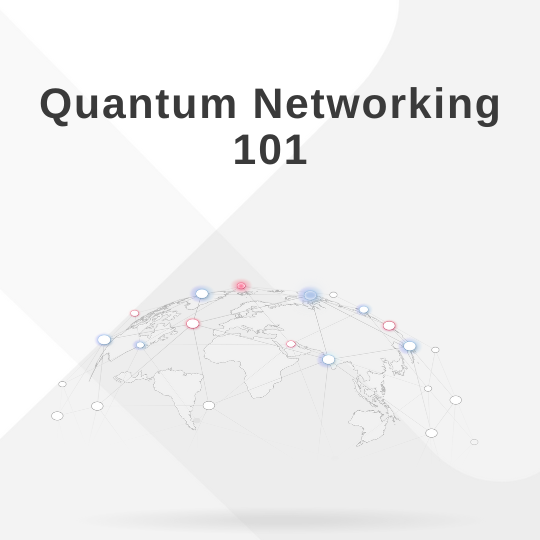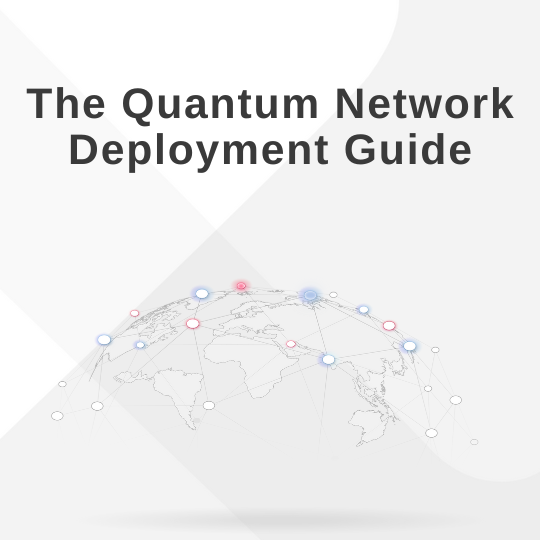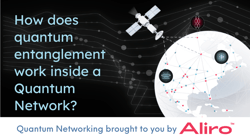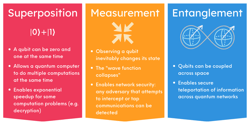Introduction to Quantum Networking
Quantum networking is often talked about in terms that are abstract or futuristic, even though quantum networks are being built today by governments, utilities companies, financial institutions, and other enterprises that need to protect highly sensitive data-in-transit. We explain the basics of what a quantum network is, how it works and why it matters. Resources to explain quantum networking in more detail can be found below.
Why does quantum networking matter?
The most urgent issue that quantum networks address is the threat of advanced attacks on our secure network infrastructure. Today’s classical encryption (RSA, ECC, Diffie-Hellman) is based on mathematical problems that are increasingly vulnerable to threats from quantum computing. Quantum Secure Communications (QSC) is uniquely enabled by quantum networking, offering a physics-based alternative. These methods don’t rely on computational hardness and are immune to brute force or algorithmic attacks, even by quantum computers.
Quantum networks are not only deployed to provide security. They also:
- Interconnect quantum processing units and quantum computers to scale computing power.
- Connect quantum sensors to enhance precision measurements for capabilities such as PNT (position, navigation, and timing).
- Support blind quantum computing, where users compute securely on remote quantum devices without revealing their data.
Classical Networks vs. Quantum Networks
Both classical networks and quantum networks transmit information from one location to another location, but they operate very differently with different hardware components, protocols, and capabilities. Quantum networks use the principles of quantum mechanics to perform functions that classical networks cannot achieve.
Quantum networking offers ultra-secure communications at a level not possible with classical networking. In classical encryption, security relies on the computational hardness of certain mathematical problems: it isn’t feasible with current technology to crack these encryption schemes. Any encryption based on mathematics could be cracked in the future by more powerful computers. Quantum communication protocols derive security from physics, not mathematics. Quantum Secure Communications allows two parties to generate shared secret keys that are guaranteed secure by quantum mechanics. By leveraging physics, quantum networks provide virtually unhackable interconnects between parties.
Quantum networks are not standalone infrastructure: they are integrated into classical networks. Quantum networks can use the same optical fiber that is already deployed and can take the place of increasingly vulnerable encryption schemes.
Bits vs. Qubits
A bit is the basic unit of information in classical computing and communications. A bit can have a defined value of either 1 or 0. Classical networks carry these bits in packets that can be copied or stored easily, and repeaters and routers can be used to extend these network links across long distances.
Quantum technologies use quantum bits (qubits) to perform computations, manipulate information, and to send and receive data. While similar in functionality to classical bits, qubits are fundamentally different. They are encoded with a quantum state, which is a specific description of the qubit's behavior, like spin or polarization. This description tells us everything we need to know about that qubit and how it behaves. There are many ways to encode a qubit, but for quantum networks qubits are typically polarization encoded photons. You can find out more about qubits in the on-demand webinar Qubits: Understanding Quantum Information.
A qubit does not carry definite classical information until it is measured. While in superposition, it is described by a probability distribution over 0 and 1, but it does not have a definite value of 0 or 1 until the act of measurement collapses the state. Once measured, the information a qubit contains is no longer quantum information in superposition; it becomes classical information. This also means that a qubit can’t be copied without altering its state. This makes it capable of functions classical bits can’t perform, such as eavesdropper detection. An eavesdropper on a classical link can copy bits and then decrypt the message they carry. On a quantum link, copying qubits is physically impossible: intercepting the qubit will disturb it, and alert the legitimate parties to the presence of an eavesdropper. This property, called the no-cloning theorem, also presents challenges in extending the distance between quantum links. Because qubits can’t be copied and can’t be stored for extended periods of time, quantum repeaters and quantum memories work fundamentally differently than classical repeaters and memories.
Transmitting Data
Classical networks use signals that can be amplified and routed as needed. These signals are broken up into packets that are then sent through intermediate routers. These classical routers read and copy the data, effectively amplifying and increasing the distance the data can travel.
In quantum networks, qubits cannot be amplified like classical bits. A quantum router does not read the full quantum state of a qubit and quantum information can’t be copied. Instead, quantum networks distribute entanglement across network links to transfer quantum states across the network without measuring them. Ultimately, quantum networks use a combination of entanglement and classical messages to teleport the quantum state contained by qubits, creating an end-to-end quantum link. This process of using entanglement to extend the distance of quantum links is explored in detail in the on-demand webinar Quantum Networking 101.
The Quantum Network Stack
A quantum network stack has 5 layers.
The quantum network stack is the implementation of protocols needed to accomplish our two big quantum networking goals of distributing entanglement and then utilizing the distributed entanglement.
At the physical layer are quantum hardware components that make up the quantum network.
At the link layer are entanglement generation protocols.
At the network layer are entanglement distribution protocols.
At the transport layer are protocols that transmit qubits.
At the application layer are the software components that drive your specific use case, such as Quantum Secure Communications.
Quantum networking does require using some specialized components that makes quantum communication and key distribution possible. The video below gives a high-level overview.
In addition to these layers are three core software elements that help organizations design, build, run, and manage their quantum networks:
#1 A physics-accurate quantum network simulator. A quantum network simulator is essential for testing and iterating on your network design. A quantum network simulator can help you identify which components will be best suited to your specific network needs. A capable quantum network simulator should model protocols as well the underlying physics (eg - fiber loss/dispersion, laser characteristics, detector behavior) so performance can be accurately predicted well in advance of procuring any expensive hardware. The quantum network will be able to operate largely on your existing network fiber. Given the distances and fiber properties you already know, you can predict the key rate that a variety of hardware configurations would provide. Predicting the key performance metrics accurately de-risks your quantum network deployment before you build. As you expand and upgrade your network, a quantum network simulator can help you achieve the best outcomes.
#2 An SDN-style orchestrator. An orchestrator is the part of the quantum networking stack that manages the hardware. It establishes any APIs that the applications layer can connect through, enabling secure communication between defined endpoints, with a defined key rate over a specified amount of time. An orchestrator maintains a queue of these requests. An SDN-style orchestrator provides a unified application to leverage automated network operations. It allows a network operator to manages services, route entanglement, coordinate hardware across the network, and also to track the health of the network (QBER, secret key rates, entanglement fidelity, etc).
#3 A real-time operating system (OS). A real-time operating system operates on each node of the network, acting as the low-level control brain for the quantum hardware stack. The OS controls and monitors the individual hardware components, executes adaptive protocols, and enables sub-nanosecond messaging that quantum hardware requires to function.

Quantum networking is not an abstract vision of the future; it is a rapidly emerging reality. From securing critical infrastructure against quantum threats, to enabling entirely new capabilities like distributed quantum computing and quantum-enhanced sensing, these networks will redefine how information is shared and protected. The risks of waiting are clear: adversaries are already preparing for Q-Day, and organizations that move too slowly may find themselves unprepared when quantum computers reach cryptographically relevant power.
Now is the time to explore, test, and deploy quantum-secure solutions. With resources like our white papers, webinars, and deployment guides, you can take the first steps toward quantum-readiness today—without waiting for the threat to become urgent. Start building your quantum advantage today:
- Check out Aliro's YouTube channel
- Explore our Quantum Networking white papers
- Watch our live and on-demand webinars
- Subscribe to the Quantum Connect Newsletter for the latest updates on quantum networks
- Reach out to our sales team for a demo

Quantum Networking 101
In this white paper the protocols, hardware and software components employed by quantum networks, and the use cases and applications that are enabled by these networks are explained through the example of a 5-node quantum network.
View or Download
Quantum Networks for Secure Data Center Connectivity
As new sophisticated threats escalate, securing high-risk data center links demands a layered approach combining PQC, QKD, and QSC to protect the sensitive data underpinning enterprise and national infrastructure.
View or Download
The Quantum Network Deployment Guide
This guide is for organizations exploring real-world quantum network implementation. This guide turns the seemingly complex vision of quantum communications at-scale into achievable short- and long-term milestones.
View or DownloadWebinars from Aliro:
Qubits: Understanding Quantum Information
This on-demand webinar is a deep dive into the different types of qubits and the fundamentals of how qubits are used in a quantum network. 
In this webinar you will learn:
- The pros and cons of different types of qubits
- How qubits are encoded
- The role of transducers in a quantum network
- How to address quantum errors
- How qubits travel through a quantum network
How does quantum entanglement work inside a Quantum Network?

Quantum networks use entanglement to transmit information securely without exposing the information to the network. Entanglement can also be used to network quantum computers and distributed quantum sensors for increased performance.
In this webinar you will learn:
- How entanglement works in a Quantum Secure Communications system
- How teleportation works
- How entanglement swapping is performed
- Why using entanglement achieves maximum security in a network
Building Unhackable Communications with Quantum Networks
This on-demand webinar is an in-depth tour of entanglement-based quantum networking: a provably secure way to protect data and communications. In this webinar you will learn:
- How software-defined platforms enable organizations to design, verify, pilot, deploy, and run full-scale quantum networks.
- How to transition smoothly: no quantum computers required, no replacement of fiber optics necessary.
- Use cases from across industries and sectors already implementing quantum-secure networking, such as public sector agencies, telecom, and financial institutions.
More quantum networking education from Aliro:
What are these principles of quantum mechanics that make quantum networks so powerful?

Click here to read the full blog post.
How are quantum networks integrated into classical networks?
What is Q-Day?
When we talk about why quantum networks are necessary, we need to talk about the threats that exist today, and the threats that are just around the corner.
Threats to RSA, Diffie-Hellman, and Elliptical Curve Cryptography
Let’s get really specific about what the vulnerabilities are and why they exist. What threat do quantum computers actually pose?
When should I worry about Q-Day?
These are serious security vulnerabilities that we need to confront if we’re going to protect sensitive data and critical infrastructure for the long term. When do you actually need to worry about Q-Day?
The Countdown to a Cryptographically-relevant Quantum Computer
Gartner recently estimated that we might see a cryptographically relevant quantum computer as early as 2029. Why does that timeline keep creeping up?
Isn't Post-Quantum Cryptography PQC enough?
With standards for PQC being released by NIST, we get this question a lot: isn’t PQC enough? Why would anyone use other methods?
Quantum Secure Communications Demo
Quantum networking secures communications across high-value, sensitive data links. But what does actually using a quantum network look like for end users and operators? Cara Alexander, Product Manager at Aliro, and Geoff Mitchell, Software Engineer at Aliro, walk us through the process.

